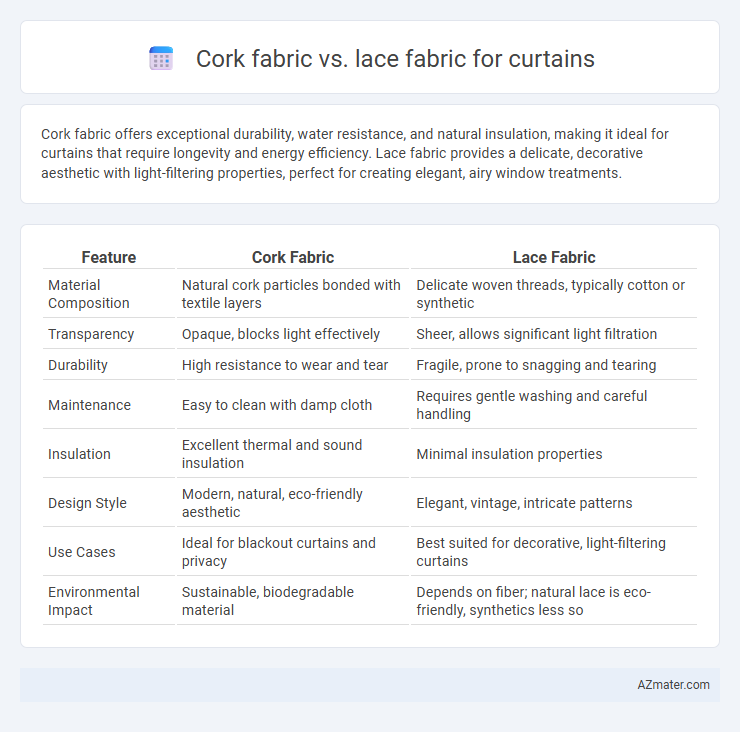Cork fabric offers exceptional durability, water resistance, and natural insulation, making it ideal for curtains that require longevity and energy efficiency. Lace fabric provides a delicate, decorative aesthetic with light-filtering properties, perfect for creating elegant, airy window treatments.
Table of Comparison
| Feature | Cork Fabric | Lace Fabric |
|---|---|---|
| Material Composition | Natural cork particles bonded with textile layers | Delicate woven threads, typically cotton or synthetic |
| Transparency | Opaque, blocks light effectively | Sheer, allows significant light filtration |
| Durability | High resistance to wear and tear | Fragile, prone to snagging and tearing |
| Maintenance | Easy to clean with damp cloth | Requires gentle washing and careful handling |
| Insulation | Excellent thermal and sound insulation | Minimal insulation properties |
| Design Style | Modern, natural, eco-friendly aesthetic | Elegant, vintage, intricate patterns |
| Use Cases | Ideal for blackout curtains and privacy | Best suited for decorative, light-filtering curtains |
| Environmental Impact | Sustainable, biodegradable material | Depends on fiber; natural lace is eco-friendly, synthetics less so |
Introduction to Cork Fabric and Lace Fabric
Cork fabric is a sustainable, natural material made from thin sheets of cork bark bonded to a fabric backing, offering durability, water resistance, and unique texture ideal for modern curtain designs. Lace fabric, characterized by its intricate, open-weave patterns crafted from threads like cotton or polyester, provides a delicate, airy aesthetic that enhances light filtration and adds elegance to window treatments. Both materials serve distinct stylistic and functional needs in curtains, with cork offering robustness and insulation, while lace emphasizes decorative transparency.
Key Properties of Cork Fabric
Cork fabric for curtains offers excellent insulation, soundproofing, and moisture resistance, making it highly durable and energy-efficient. Unlike lace fabric, cork provides better UV protection and privacy due to its opaque and dense texture. Its natural hypoallergenic and eco-friendly properties add further value for sustainable interior design.
Key Properties of Lace Fabric
Lace fabric for curtains offers a delicate, breathable texture with intricate patterns that allow natural light to filter softly into a room, enhancing aesthetic appeal while maintaining some privacy. Its lightweight nature makes lace ideal for layering with heavier drapes or using alone in warm climates to promote airflow and reduce heat buildup. Unlike cork fabric, lace emphasizes elegance and transparency rather than insulation or soundproofing, making it a popular choice for decorative rather than functional curtain uses.
Aesthetic Appeal: Cork vs Lace Curtains
Cork curtains offer a unique, natural aesthetic with a textured, earthy appearance that adds warmth and a rustic charm to interiors, making them ideal for eco-friendly and modern rustic decor styles. Lace curtains provide a delicate, intricate pattern that enhances light filtration and adds an elegant, vintage, or romantic touch to any room, perfect for traditional or shabby chic designs. While cork creates a bold and organic statement, lace emphasizes softness and detail, allowing homeowners to choose based on the desired ambiance and light diffusion.
Durability and Longevity Comparison
Cork fabric offers superior durability and longevity compared to lace fabric, as it is resistant to wear, moisture, and UV damage, making it ideal for curtains exposed to sunlight and humidity. Lace fabric, while aesthetically delicate and lightweight, tends to be more prone to tearing, discoloration, and fabric weakening over time, reducing its lifespan in high-traffic or sun-exposed areas. For long-lasting curtain applications, cork fabric provides a robust and maintenance-friendly option that maintains structural integrity much longer than lace.
Sustainability and Eco-Friendliness
Cork fabric for curtains offers superior sustainability due to its natural, renewable cork oak bark source, which is harvested without harming the tree, ensuring continuous growth and carbon absorption. Lace fabric, typically made from cotton or synthetic fibers, often involves intensive water use and chemical treatments, raising environmental concerns. Cork's biodegradability and low-impact manufacturing process make it a more eco-friendly choice compared to traditional lace curtains.
Ease of Care and Maintenance
Cork fabric offers superior ease of care and maintenance for curtains due to its natural resistance to moisture, stains, and mold, requiring only occasional dusting or light wiping with a damp cloth. Lace fabric demands more delicate handling, often needing gentle hand washing or dry cleaning to prevent damage and maintain its intricate patterns. Cork fabric's durability and low-maintenance nature make it a practical choice for long-lasting, easy-to-clean curtains compared to the high-maintenance requirements of lace.
Privacy and Light Control
Cork fabric offers superior privacy and light control for curtains due to its dense, natural cellular structure that blocks out light and prevents visibility from outside. Lace fabric provides minimal privacy with its open, delicate weave allowing light to filter through while maintaining a decorative aesthetic. Choosing cork fabric is ideal for rooms requiring darkness and discretion, whereas lace fabric suits spaces where light diffusion and decorative effects are preferred.
Cost and Value for Money
Cork fabric offers durability and natural insulation at a moderate price, making it a cost-effective choice for long-term curtain use. Lace fabric is generally more affordable upfront but may require frequent replacement due to its delicate nature, reducing overall value for money. When balancing cost and longevity, cork fabric provides better value for money compared to lace for curtains.
Choosing the Right Fabric for Your Curtains
Cork fabric offers a unique combination of natural insulation, durability, and eco-friendliness, making it ideal for energy-efficient curtains that reduce noise and block light effectively. Lace fabric provides a delicate, airy aesthetic with intricate patterns that allow light to filter through softly, creating a decorative and elegant window treatment. Selecting between cork and lace fabric for curtains depends on your priorities for insulation, light control, and design style to best complement your room's ambiance and functionality.

Infographic: Cork fabric vs Lace fabric for Curtain
 azmater.com
azmater.com